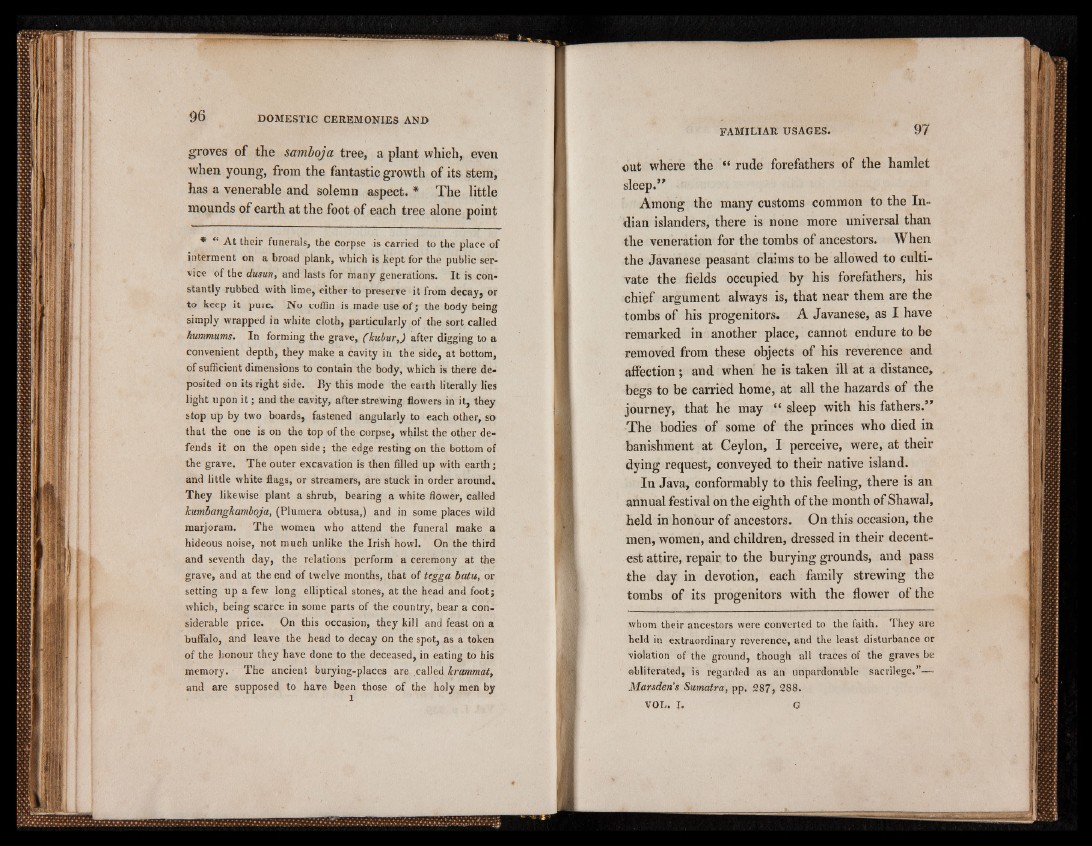
groves of the samboja tree, a plant which, even
when young, from the fantastic growth of its stem,
has a venerable and solemn aspect. * The little
mounds of earth at the foot of each tree alone point
* “ At their funerals, the corpse is carried to the place of
interment on a broad plank, which is kept for the public service
of the dusun, and lasts for many generations. I t is constantly
rubbed, with lime, either to preserve it from decay, or
to keep it pure. No coffin is made use o f; the body being
simply wrapped in white cloth, particularly of the sort called
hummums. In forming the grave, ( kubur,) after digging to a
convenient depth, they make a cavity in the side, at bottom,
of sufficient dimensions to contain the body, which is there deposited
on its right side. By this mode the earth literally lies
light upon i t ; and the cavity, after strewing flowers in it, they
stop up by two boards, fastened angularly to each other, so
that the one is on the top of the corpse, whilst the other defends
it on the open side; the edge resting on the bottom of
the grave. The outer excavation is then filled up with earth;
and little white flags, or streamers, are stuck in order around.
They likewise plant a shrub, bearing a white flower, called
kumbangkamboja, (Plumera obtusa,) and in some places wild
marjoram. The women who attend the funeral make a
hideous noise, not much unlike the Irish howl. On the third
and seventh day, the relations perform a ceremony at the
grave, and at the end of twelve months, that of tegga batu, or
setting up a few long elliptical stones, at the head and foot;
which, being scarce in some parts of the country, bear a considerable
price. On this occasion, they kill and feast on a
buffalo, and leave the head to decay on the spot, as a token
of the honour they have done to the deceased, in eating to his
memory. The ancient burying-places are called krammat,
and are supposed to have been those of the holy men by
out where the “ rude forefathers of the hamlet
sleep.”
Among the many customs common to the Indian
islanders, there is none more universal than
the veneration for the tombs of ancestors. When
the Javanese peasant claims to be allowed to cultivate
the fields occupied by his forefathers, his
chief argument always is, that near them are the
tombs of his progenitors. A Javanese, as I have
remarked in another place, cannot endure to be
removed from these objects of his reverence and
affection; and when he is taken ill at a distance,
begs to be carried home, at all the hazards of the o
journey, that he may “ sleep with his fathers.”
The bodies of some of the princes who died in
banishment at Geylon, I perceive, were, at their
dying request, conveyed to their native island.
In Java, conformably to this feeling, there is an
annual festival on the eighth of the month of Shawal,
held in honour of ancestors. On this occasion, the
men, women, and children, dressed in their decent-
est attire, repair to the burying grounds, and pass
the day in devotion, each family strewing the
tombs of its progenitors with the flower of the
whom their ancestors were converted to the faith. They are
held in extraordinary reverence, and the least disturbance or
violation of the ground, though all traces of the graves be
obliterated, is regarded as an unpardonable sacrilege.”—
Marsden’s Sumatra, pp. 287, 288.
VOL. I. G